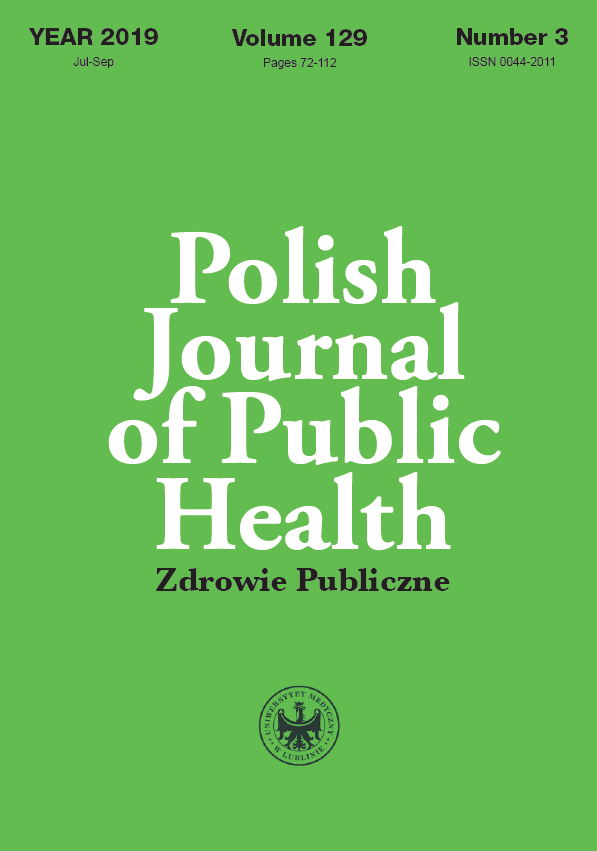Application of quantile regression in environmental epidemiology
DOI:
https://doi.org/10.2478/pjph-2019-0017Słowa kluczowe:
air pollution, ambient, exposure, correlation, modelAbstrakt
Introduction. Among many problems present in studies evaluating associations between health conditions and exposure to ambient air pollution, there is the correlation between environmental factors. These issues are usually resolved by providing a correlation matrix for the parameters of interest.
Aim. To explore correlations between environmental factors.
Material and methods. As sample data we use environmental factors presented in Milan mortality data (Italy, 1980-1989) and emergency department visits for asthma in Windsor (Canada, 2004-2010). Here, we propose to use a series of quantile regression evaluations to emphasize and identify dependency among environmental factors.
Results. This presentation outlines an important role to investigate the potential correlations among ambient air pollutants, weather factors, and the values of the Canadian Air Quality Health Index (AQHI). In environmental epidemiology studies, these components are usually used in a common statistical model. Their correlations affect the values of the estimated relative risks, odds ratios or other estimated health effects. The presented approach examines associations among the factors as well as changes in correlations along quantiles. The examples used in this study explain various environmental phenomena; for example, the negative relationship between ambient ozone and nitrogen dioxide.
Conclusions. By a consequence, this work can aid in further developing policies aimed at reducing the health impacts of air pollution as it allows to identify highly correlated factors in the constructed models.
Bibliografia
1. Szyszkowicz M. Remarks on ambient air pollution and health outcomes. ISRN Public Health. 2013. http://dx.doi.org/10.1155/2013/846297.
2. Szyszkowicz M, Kousha T, Castner J, Dales R. Air pollution and emergency department visits for respiratory diseases: A multi-city case crossover study. Environ Res. 2018;163:263-9.
3. Szyszkowicz M, Thomson EM, Colamn I, Rowe BH. Ambient air pollution exposure and Emergency Department visits for substance abuse. PLoS One. 2018;13(6):e0199826.
4. Koenker R, Bassett G. Regression Quantiles. Econometrica. 1978;46:33- 50.
5. Koenker R, Hallock KF. Quantile regression. J Econ Perspect. 2001;15(4):143-56.
6. Stieb DM, Burnett RT, Smith-Doiron M, Brion O, Shin HH, Economou V. A new multipollutant, no-threshold air quality health index based on short-term associations observed in daily time-series analyses. J Air Waste Manag Assoc. 2013;58:435-50.
7. Wand M. The package “SemiPar” in the R library. In the package milan mortaity data frame. Functions for semiparametric regression analysis, to complement the book: D. Ruppert, M. P. Wand, R. J. Carroll. Semiparametric Regression. Cambridge University Press; 2015. http://www.use-r. com/SPmanu.pdf.
8. Zanobetti A, Wand MP, Schwartz J, Ryan LM. Generalized additive distributed lag models: quantifying mortality displacement. Biostatistics. 2000;1(3):279-92.
9. Szyszkowicz M, Burr WS. Distributed Lag Models: an analysis of milan mortality aata. J Pollut Eff Cont. 2014;2:109.
10. Szyszkowicz M, Kousha T. Emergency department visits for asthma in relation to the Air Quality Health Index: a case-crossover study in Windsor, Canada. Can J Public Health. 2014;105(5):336-341.
Pobrania
Opublikowane
Numer
Dział
Licencja
Prawa autorskie (c) 2020 Polish Journal of Public Health

Praca jest udostępniana na licencji Creative Commons Attribution-NonCommercial-NoDerivatives 3.0 Unported License.


